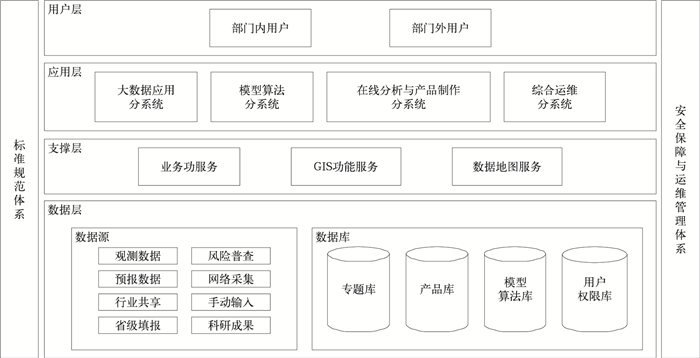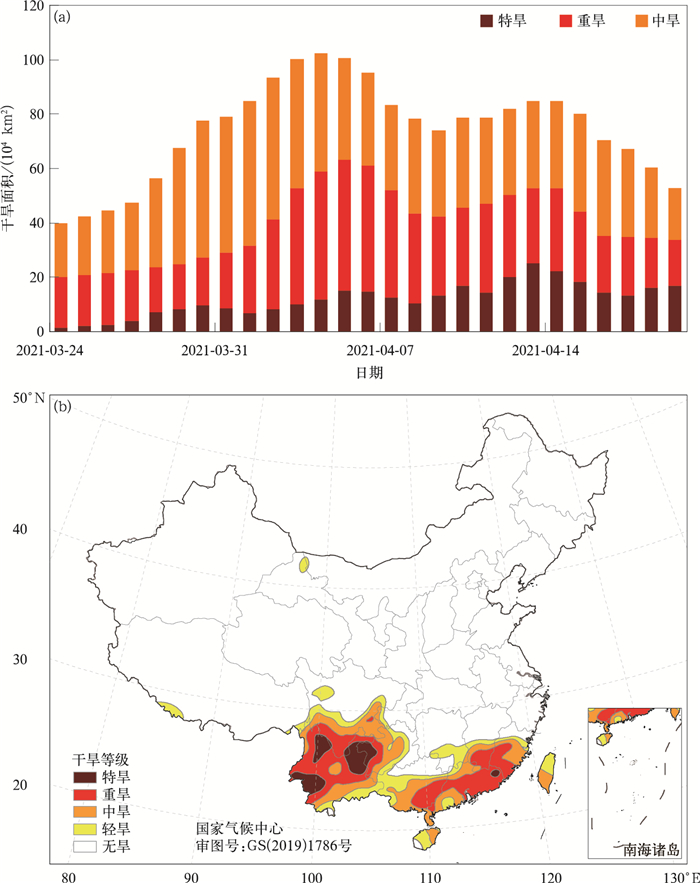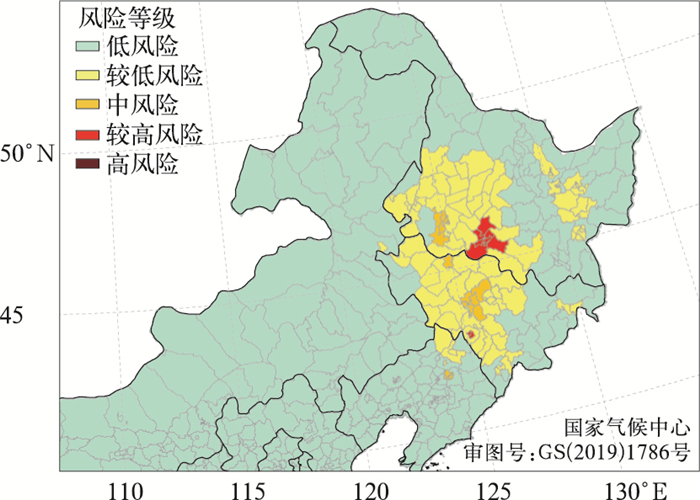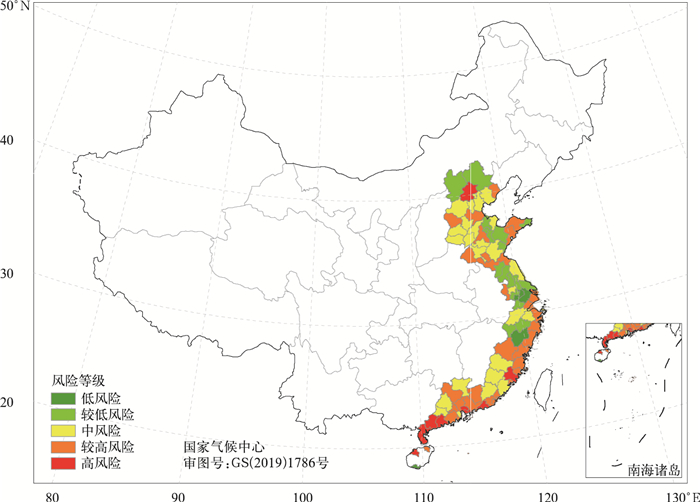Design and Implementation of Meteorological Disaster Risk Management System
-
摘要: 为满足我国气象灾害风险管理业务体系建立和发展的需求,有效支撑防灾减灾决策服务,设计并建设了气象灾害风险管理系统。该系统包括大数据应用、模型算法、在线分析与产品制作、综合运维等分系统,面向暴雨、台风、干旱、高温、低温等主要气象灾害,覆盖气象灾害风险管理业务的主要环节,实现灾害监测识别、影响评估、风险评估、风险预估和风险区划等功能。系统探索应用时空匹配的大数据融合、Web-GIS、空间数据分布式存储、微服务和多租户等技术。目前,系统可实现实时发布灾情监测、灾害事件识别、影响评估、风险评估、风险预估、风险区划等多类业务产品。在国家级气象业务部门的应用显示,该系统具有良好的业务能力与发展前景,有助于推进客观化、定量化、精细化气象灾害风险管理业务发展,提升防灾减灾决策服务能力。Abstract: China is one of the countries with the most serious meteorological disasters in the world. Reducing disaster losses and mitigating disaster risks is important for improving social governance and enhancing people's welfare, and it is also the fundamental goal of meteorological services. As a non-engineering measure for disaster prevention and mitigation, Meteorological Disaster Risk Management System (MDRMS) provides users with reference for decision making and is one of the most effective tools for mitigating meteorological disaster risks. In order to effectively reduce the risk of meteorological disasters and meet the urgent needs of service, China National Climate Center has designed and built MDRMS. MDRMS provides decision-makers and other stakeholders with professional services with four sub-systems:Big data application sub-system, model algorithm sub-system, online analysis sub-system, and comprehensive operation sub-system.From the view of application and function, MDRMS realizes the functions of disaster monitoring and identification, disaster impact assessment, risk assessment, risk prediction, risk zoning, and disaster information services for major meteorological disasters such as rainstorm, typhoon, drought, high temperature and low temperature. A series of products are also established.From the view of design and construction, the key technologies adopted are generic and the operation is intuitive and friendly. The system is built with key technologies such as big data fusion based on spatial-temporal matching, Web-GIS, distributed spatial data storage, micro service, and multi-tenant. The application of new technologies significantly improves the access efficiency and application capability of the system to multi-source, heterogeneous and massive data related to meteorology disaster risk management and enhances the user experience.From the view of deployment and openness, MDRMS has better integration, openness and scalability. It is deployed in China Meteorological Administration, ensuring access, personalized configuration, and service customization for internal users at four levels:National, provincial, municipal, and county levels, as well as access for external users at some product levels.The implementation of MDRMS shows that it has good operational capability and development prospect, which promotes the objective development of meteorological disaster risk management operation and enhances disaster prevention and mitigation decision-making service capability. In the future, the system will be improved following the principle of intensification, integration, and objectification. It will be integrated with the meteorological big data cloud platform in terms of data environment, product interfaces and algorithm functions, and provincial versions and mobile versions will be vigorously developed, focusing on creating an application ecosystem for MDRMS, providing richer and more practical meteorological disaster risk management products for users at all levels, and further playing an important role of information technology in meteorological disaster risk management.
-
表 1 数据类别表
Table 1 Data types
数据类别 主要数据和产品集 致灾因子 站点观测、数值模式、台风路径和登陆信息等 承灾体 人口、社会经济、兴趣点等 孕灾环境 地形、土地利用、植被类型、河流分布、城市排水管网密度、城市绿地率等 灾害影响 灾情直报、省级灾情、县级灾情、重大灾害事件等 灾害事件 暴雨事件、干旱事件、低温事件、高温事件、台风等 风险评估 暴雨风险评估、干旱风险评估、低温风险评估、高温风险评估、台风风险评估、城市内涝风险评估等 风险预估 暴雨风险预估、干旱风险预估、低温风险预估、高温风险预估、台风风险预估等 风险区划 暴雨风险区划、干旱风险区划、低温风险区划、高温风险区划、台风风险区划等 风险普查 隐患点、预警点、致灾阈值、脆弱性曲线、中小河流洪水风险区划、山洪风险区划、城市内涝风险区划、风暴潮风险区划等 行业评估 农业、交通、环境、水资源等 评估指标 灾体量指数、气候指数、台风能量指数等 行业信息 农业、环境、水文水利等 基础信息 行政区划、气象站、水文站、水库、水资源分区、中小河流流域分区、山洪沟分区等 -
[1] 中国气象局.中国气象灾害年鉴2020.北京:气象出版社, 2021.China Meteorological Administration. China Meteorological Disaster Yearbook 2020. Beijing: China Meteorological Press, 2021. [2] 中国气象局. 中国极端天气和灾害风险管理评估报告. 北京: 科学出版社, 2015.China Meteorological Administration. Assessment Report on Extreme Weather and Disaster Risk Management in China. Beijing: Science Press, 2015. [3] IPCC. Climate Change 2014: Impacts, Adaptation, and Vulnerability. Cambridge and New York: Cambridge University Press, 2014. [4] IPCC. Managing The Risks of Extreme Events and Disasters to Advance Climate Change Adaptation: A Special Report of Working Groups Ⅰ and Ⅱ of the Intergovernmental Panel on Climate Change. Cambridge and New York: Cambridge University Press, 2012. [5] 李莹, 高歌, 宋连春. IPCC第五次评估报告对气候变化风险及风险管理的新认知. 气候变化研究进展, 2014, 10(4): 260-267. doi: 10.3969/j.issn.1673-1719.2014.04.006Li Y, Gao G, Song L C. Understanding of disaster risk and the management associated with climate change in IPCC AR5. Climate Change Research, 2014, 10(4): 260-267. doi: 10.3969/j.issn.1673-1719.2014.04.006 [6] 史培军. 仙台框架: 未来15年世界减灾指导性文件. 中国减灾, 2015(4): 30-33. doi: 10.3969/j.issn.1002-4549.2015.04.009Shi P J. Sendai framework: World disaster reduction guidance document for the next 15 years. China Disaster Reduction, 2015(4): 30-33. doi: 10.3969/j.issn.1002-4549.2015.04.009 [7] 阚凤敏. 联合国引领国际减灾三十年: 从灾害管理到灾害风险管理(1990-2019年). 中国减灾, 2020(5): 54-59. https://www.cnki.com.cn/Article/CJFDTOTAL-ZGJI202005015.htmKan F M. 30 years of international disaster reduction led by the United Nations: From disaster management to disaster risk management(1990-2019). China Disaster Reduction, 2020(5): 54-59. https://www.cnki.com.cn/Article/CJFDTOTAL-ZGJI202005015.htm [8] Svoboda M D, Fuchs B A, Poulsen C C, et al. The drought risk atlas: Enhancing decision support for drought risk management in the United States. J Hydrol, 2015, 526: 274-286. doi: 10.1016/j.jhydrol.2015.01.006 [9] Shi P J, Kasperson R. World Atlas of Natural Disaster Risk. Berlin: Springer, 2015. [10] 国家气候中心. 中国极端天气气候图集(1961-2015). 北京: 气象出版社, 2018.National Climate Center. Atlas of Extreme Weather and Climate in China(1961-2015). Beijing: China Meteorological Press, 2018. [11] 郑治斌. 信息化推动气象灾害风险管理的趋势. 湖北农业科学, 2018, 57(14): 118-121. https://www.cnki.com.cn/Article/CJFDTOTAL-HBNY201814030.htmZheng Z B. The trend of meteorological disaster risk management promoted by informatization. Hubei Agri Sci, 2018, 57(14): 118-121. https://www.cnki.com.cn/Article/CJFDTOTAL-HBNY201814030.htm [12] Jiao M Y, Song L C, Jiang T, et al. China's implementation of impact and risk-based early warning. Boletín-Organización Meteorológica Mundial, 2015, 64: 11-14. [13] 陈振林. 我国气象防灾减灾能力建设与实践. 阅江学刊, 2013(3): 21-25. https://www.cnki.com.cn/Article/CJFDTOTAL-YJXK201303007.htmChen Z L. Capacity building and practice of meteorological disaster prevention and mitigation. Yuejiang Academic Journal, 2013(3): 21-25. https://www.cnki.com.cn/Article/CJFDTOTAL-YJXK201303007.htm [14] 庄瑶, 鲍瑞娟, 张容焱, 等. 福建热带气旋灾害精细化危险性评估. 应用气象学报, 2022, 33(3): 319-328. doi: 10.11898/1001-7313.20220306Zhuang Y, Bao R J, Zhang R Y, et al. Refined rsik assessment of tropical cyclone disaster in Fujian. J Appl Meteor Sci, 2022, 33(3): 319-328. doi: 10.11898/1001-7313.20220306 [15] 章国材. 气象云建设的研究与思考. 气象与环境科学, 2015, 38(4): 1-11. https://www.cnki.com.cn/Article/CJFDTOTAL-HNQX201504001.htmZhang G C. Study and thinking on the construction of meteorological cloud. Meteor Environ Sci, 2015, 38(4): 1-11. https://www.cnki.com.cn/Article/CJFDTOTAL-HNQX201504001.htm [16] 沈文海. 气象信息化进程中云计算的意义. 中国信息化, 2015(3): 80-88. https://www.cnki.com.cn/Article/CJFDTOTAL-IGXN201503030.htmShen W H. Significance of cloud computing in the process of meteorological informatization. Informatization Research, 2015(3): 80-88. https://www.cnki.com.cn/Article/CJFDTOTAL-IGXN201503030.htm [17] 沈文海. 再析气象大数据及其应用. 中国信息化, 2016(1): 85-96. https://www.cnki.com.cn/Article/CJFDTOTAL-IGXN201601032.htmShen W H. Reanalysis of meteorological big data and its application. Informatization Research, 2016(1): 85-96. https://www.cnki.com.cn/Article/CJFDTOTAL-IGXN201601032.htm [18] 吴焕萍, 张永强, 孙家民, 等. 气候信息交互显示与分析平台(CIPAS)设计与实现. 应用气象学报, 2013, 24(5): 631-640. doi: 10.3969/j.issn.1001-7313.2013.05.013Wu H P, Zhang Y Q, Sun J M, et al. Designing and implementation of climate interactive plotting and analysis system. J Appl Meteor Sci, 2013, 24(5): 631-640. doi: 10.3969/j.issn.1001-7313.2013.05.013 [19] 赵芳, 熊安元, 张小缨, 等. 全国综合气象信息共享平台架构设计技术特征. 应用气象学报, 2017, 28(6): 750-758. doi: 10.11898/1001-7313.20170610Zhao F, Xiong A Y, Zhang X Y, et al. Technical characteristics of the architecture design of China integrated meteorological information sharing system. J Appl Meteor Sci, 2017, 28(6): 750-758. doi: 10.11898/1001-7313.20170610 [20] 肖华东, 孙婧, 孙朝阳, 等. 中国气象局S2S数据归档中心设计及关键技术. 应用气象学报, 2017, 28(5): 632-640. doi: 10.11898/1001-7313.20170511Xiao H D, Sun J, Sun C Y, et al. Design of CMA S2S data archive center and key technology. J Appl Meteor Sci, 2017, 28(5): 632-640. doi: 10.11898/1001-7313.20170511 [21] 王昕, 王国复, 黄小猛. 科学大数据在全球气候变化研究中的应用. 气候变化研究进展, 2016, 12(4): 313-321. https://www.cnki.com.cn/Article/CJFDTOTAL-QHBH201604007.htmWang X, Wang G F, Huang X M. The application of scientific big data in the research of global climate change. Climate Change Research, 2016, 12(4): 313-321. https://www.cnki.com.cn/Article/CJFDTOTAL-QHBH201604007.htm [22] 石宇, 詹明, 尹璐, 等. 面向对象的多源异构数据关联组织与分析. 测绘通报, 2015(1): 102-104. https://www.cnki.com.cn/Article/CJFDTOTAL-CHTB201501025.htmShi Y, Zhan M, Yin L, et al. Research on associated organization and analysis of target-oriented multi-source heterogeneous data. Bulletin of Surveying and Mapping, 2015(1): 102-104. https://www.cnki.com.cn/Article/CJFDTOTAL-CHTB201501025.htm [23] Jeong S, Cheong T. Web GIS based typhoon committee disaster information system for typhoon disaster risk management. Tropical Cyclone Research and Review, 2012, 1(2): 207-212. [24] 胡争光, 郑卫江, 高嵩, 等. 气象GIS网络平台关键技术研究与实现. 应用气象学报, 2014, 25(3): 365-374. http://qikan.camscma.cn/article/id/20140314Hu Z G, Zheng W J, Gao S, et al. Research and implementation of key technology in MeteoGIS web platform. J Appl Meteor Sci, 2014, 25(3): 365-374. http://qikan.camscma.cn/article/id/20140314 [25] 吕终亮, 白新萍, 薛峰. 基于WebGIS气象服务产品制作系统及关键技术. 应用气象学报, 2018, 29(1): 120-128. doi: 10.11898/1001-7313.20180111Lü Z L, Bai X P, Xue F. WebGIS-based meteorological service system and its key technology. J Appl Meteor Sci, 2018, 29(1): 120-128. doi: 10.11898/1001-7313.20180111 [26] 吴焕萍, 罗兵, 王维国, 等. GIS技术在决策气象服务系统中的应用. 应用气象学报, 2008, 19(3): 380-384. http://qikan.camscma.cn/article/id/20080362Wu H P, Luo B, Wang W G, et al. Application of geographic information system to decision-making meteorological service system. J Appl Meteor Sci, 2008, 19(3): 380-384. http://qikan.camscma.cn/article/id/20080362 [27] 刘品高, 江南, 谭萍, 等. 气象地理信息系统的设计与实现. 应用气象学报, 2005, 16(4): 547-553. http://qikan.camscma.cn/article/id/20050469Liu P G, Jiang N, Tan P, et al. Design and implementation of a geographic information system for meteorological applications. J Appl Meteor Sci, 2005, 16(4): 547-553. http://qikan.camscma.cn/article/id/20050469 [28] 曾志明, 云惟英, 卢浩, 等. 大数据GIS关键技术研究与实践. 测绘与空间地理信息, 2017, 40(增刊Ⅰ): 1-8. https://www.cnki.com.cn/Article/CJFDTOTAL-XJJS201605002.htmZeng Z M, Yun W Y, Lu H, et al. Research and practice on key technologies of big data GIS. Geomatics & Spatial Information Technology, 2017, 40(Suppl Ⅰ): 1-8. https://www.cnki.com.cn/Article/CJFDTOTAL-XJJS201605002.htm [29] 云惟英, 苟宇, 王京, 等. 基于Spark Streaming的实时流数据处理模型化研究与实现. 测绘与空间地理信息, 2017, 40(增刊Ⅰ): 48-55. https://www.cnki.com.cn/Article/CJFDTOTAL-JDQW201603013.htmYun W Y, Gou Y, Wang J, et al. Research and implementation of the modules processing of real time data stream based on spark streaming. Geomatics & Spatial Information Technology, 2017, 40(Suppl Ⅰ): 48-55. https://www.cnki.com.cn/Article/CJFDTOTAL-JDQW201603013.htm [30] 苏乐乐, 熊林华. 基于容器技术的GIS服务负载均衡研究. 测绘与空间地理信息, 2017, 40(增刊Ⅰ): 67-69.Su L L, Xiong L H. Research of GIS load balance based on container technology. Geomatics & Spatial Information Technology, 2017, 40(Suppl Ⅰ): 67-69. [31] 叶殿秀, 王遵娅, 高荣, 等. 1961-2016年我国区域性暴雨过程的客观识别及其气候特征. 气候变化研究进展, 2019, 15(6): 575-583. https://www.cnki.com.cn/Article/CJFDTOTAL-QHBH201906001.htmYe D X, Wang Z Y, Gao R, et al. Objective identification and climatic characters of the regional rainstorm event in China from 1961 to 2016. Climate Change Research, 2019, 15(6): 575-583. https://www.cnki.com.cn/Article/CJFDTOTAL-QHBH201906001.htm [32] 王国复, 叶殿秀, 张颖娴, 等. 2017年我国区域性高温过程特征及异常大气环流成因分析. 气候变化研究进展, 2018, 14(4): 341-349. https://www.cnki.com.cn/Article/CJFDTOTAL-QHBH201804002.htmWang G F, Ye D X, Zhang Y X, et al. Characteristics and abnormal atmospheric circulation of regional high temperature process in 2017 over China. Climate Change Research, 2018, 14(4): 341-349. https://www.cnki.com.cn/Article/CJFDTOTAL-QHBH201804002.htm [33] 伍红雨, 邹燕, 刘尉. 广东区域性暴雨过程的定量化评估及气候特征. 应用气象学报, 2019, 30(2): 233-244. doi: 10.11898/1001-7313.20190210Wu H Y, Zou Y, Liu W. Quantitative assessment of regional heavy rainfall process in Guangdong and its climatological characteristics. J Appl Meteor Sci, 2019, 30(2): 233-244. doi: 10.11898/1001-7313.20190210 [34] 何立富, 陈双, 郭云谦. 台风利奇马(1909)极端强降雨观测特征及成因. 应用气象学报, 2020, 31(5): 513-526. doi: 10.11898/1001-7313.20200501He L F, Chen S, Guo Y Q. Observation characteristics and synoptic mechanisms of Typhoon Lekima extreme rainfall in 2019. J Appl Meteor Sci, 2020, 31(5): 513-526. doi: 10.11898/1001-7313.20200501 [35] Wang Y J, Yin Y Z, Song L C. Risk assessment of typhoon disaster chains in the Guangdong-Hong Kong-Macau Greater Bay Area, China. Front Earth Sci, 2022. DOI: 10.3389/feart.2022.839733. [36] Sun S, Zhai J Q, Li Y, et al. Urban waterlogging risk assessment in well-developed region of Eastern China. Phys Chem Earth, 2020, 115: 102824. [37] 刘媛媛, 何文春, 王妍, 等. 气象大数据云平台归档系统设计及实现. 气象科技, 2021, 49(5): 697-706. https://www.cnki.com.cn/Article/CJFDTOTAL-QXKJ202105006.htmLiu Y Y, He W C, Wang Y, et al. Design and implementation of meteorological big data cloud platform archive storage system. Meteor Sci Tech, 2021, 49(5): 697-706. https://www.cnki.com.cn/Article/CJFDTOTAL-QXKJ202105006.htm [38] 杨建莹, 霍治国, 王培娟, 等. 中国北方苹果干旱等级指标构建及危险性评价. 应用气象学报, 2021, 32(1): 25-37. doi: 10.11898/1001-7313.20210103Yang J Y, Huo Z G, Wang P J, et al. Evaluation index construction and hazard risk assessment on apple drought in northern China. J Appl Meteor Sci, 2021, 32(1): 25-37. doi: 10.11898/1001-7313.20210103 [39] 郑艳姣, 杨再强, 王琳, 等. 中国南方设施番茄高温热害风险区划. 应用气象学报, 2021, 32(4): 432-442. doi: 10.11898/1001-7313.20210405Zheng Y J, Yang Z Q, Wang L, et al. Refined risk zoning of high temperature and heat damage to greenhouse tomato in Southern China. J Appl Meteor Sci, 2021, 32(4): 432-442. doi: 10.11898/1001-7313.20210405 [40] 黄晓远, 李谢辉. 基于CMIP6的西南暴雨洪涝灾害风险未来预估. 应用气象学报, 2022, 33(2): 231-243. doi: 10.11898/1001-7313.20220209Huang X Y, Li X H. Future projection of rainstorm and flood disaster risk in Southwest China based on CMIP6 models. J Appl Meteor Sci, 2022, 33(2): 231-243. doi: 10.11898/1001-7313.20220209 -


 设为首页
设为首页 加入收藏
加入收藏



 下载:
下载:







